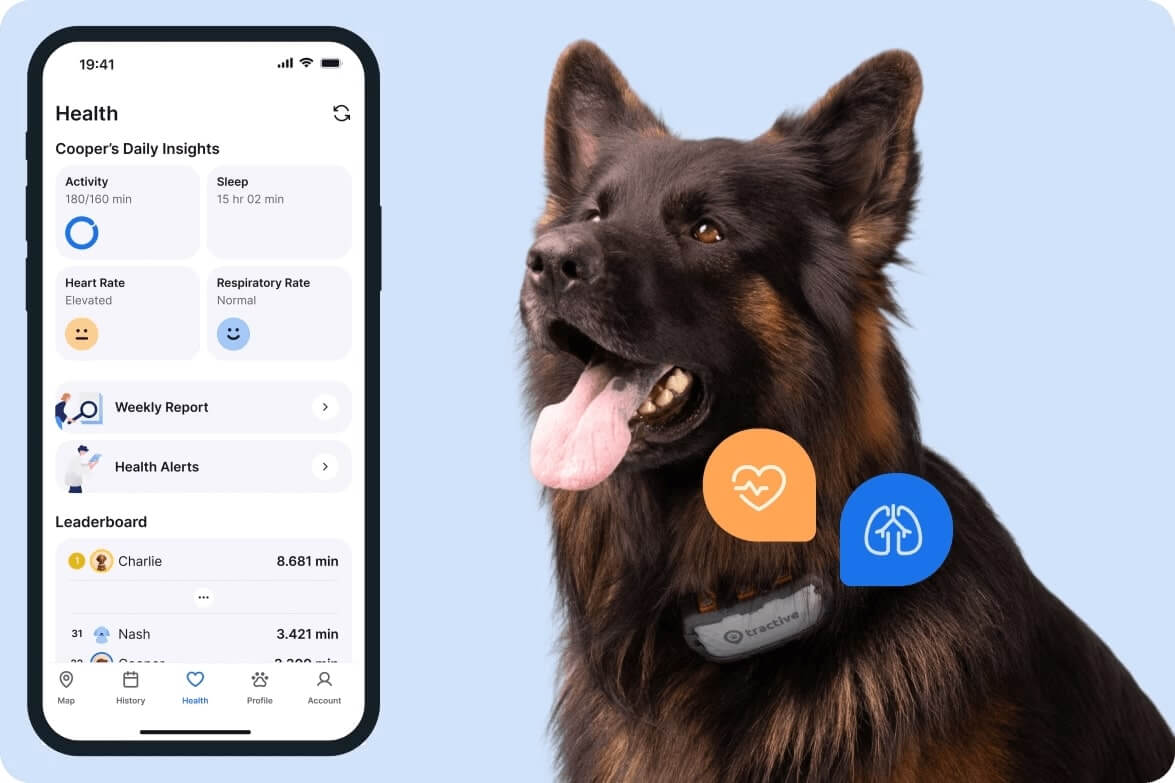 Approved by Dr. Dwight Alleyne, DVM
Approved by Dr. Dwight Alleyne, DVM How To Tell If Your Dog Is Sick: The Main Signs & Symptoms
Is your dog acting funny? Moving less? Sleeping more? It might be time to talk to your vet. Read on to learn about signs of illness in dogs & what signs can help you get them to a vet early.

Is my dog sick? That’s a question our dogs (sadly) can’t answer for us. And since they’re good at hiding what’s bothering them in the early stages of sickness or disease, it can be easy to miss the signs of illness in dogs. In this guide, we’ll talk about what subtle changes to look out for – and how a change in their activity and vital signs can be one of the first red flags.
Key Takeways
🐶 Spot the signs early: Unusual behavior, changes in appetite, vomiting, diarrhea, lethargy, or breathing issues can all signal your dog may be unwell.
😡 Behavioral clues: Watch for restlessness, hiding, aggression, or increased clinginess – dogs often express illness through subtle behavioral shifts.
👩⚕️ When to call your vet: If symptoms are severe, sudden, or persistent (e.g., difficulty breathing, seizures, or blood in stool.)
🌎 A smart dog tracker with Health Monitoring (like Tractive) helps you monitor your dog’s daily activity and vital signs – making it easier to spot changes that could indicate illness.

Always know your buddy is healthy & safe
Read more- Key Takeways
- How do I know if my dog is sick?
- What are some signs my dog is sick?
- Most common dog diseases: Symptoms & treatment
- What to do when my dog is sick?
- What to feed a sick dog with no appetite?
- What are some dog sleeping positions when sick?
- How a smart dog tracker can help you monitor their health
How do I know if my dog is sick?
The first thing to do is check if your pup is acting like their usual self. Because much like us humans, dogs tend to act differently if something is wrong with them. For example, your dog might seem:
- Less interested in food,
- Reluctant to participate during playtime
- Tired from not sleeping well enough – or sleeping too much
- Or be less active in general.
“Keep track of your dog’s energy levels, especially how long they are able to walk.
If you notice significant declines, it could be a sign of pain, heart disease, or other illness.”
– VCA Animal Hospitals1
💡With a smart dog tracker, you can spot a drop in your dog’s daily activity and energy levels quicker and easier – so you can get them to a vet earlier. Or monitor your dog’s vital signs (like their breathing and heart rate) to spot potential, easy-to-miss health issues.

Get health alerts for your dog
Our pups can’t always tell us if something’s wrong. But if their tracker detects unusual changes in their routine, you’ll get an alert, helping you catch potential issues early.
What are some signs my dog is sick?
Lethargy
Pay attention to how much your dog normally moves. Any significant change in your dog’s usual level of activity could signal that something’s wrong. Dogs in pain will typically be less active than healthy dogs – like with senior dogs, who are vulnerable to mobility-affecting conditions, like arthritis. So if your once-active dog now seems to be in a slump, get in touch with your vet for an early checkup.
Sleep disturbances
Many sick dogs will sleep more than usual, but have worse sleep quality. Pain and discomfort can get in the way of a good night’s sleep. But since dogs tend to be super sleepers, it’s easy to miss out on a change in their sleep patterns. (I.e., whether they’re sleeping more or less – or worse.)
That’s why vets say that unusual changes in your dog’s sleep may be cause for concern.1 If you notice your dog is suddenly sleeping more throughout the day, they may be sick.
“If your dog usually sleeps for 2-3 hours in the morning and then is up for the rest of the day – but then you suddenly notice they are sleeping for 5-6 hours in the morning and into the afternoon, it’s time to call the vet.”
– PetMD
Vomiting
If you notice your dog vomiting, this is a clear sign your dog is sick or at least has an upset stomach. Vomiting and diarrhea are often the most common first signs of illness. If your dog throws up once but otherwise acts normally, the issue may not be so serious. However, vomiting can also be a sign of a more serious illness.
Keep an eye on your dog and call your vet if they vomit several times within one day, vomit blood, or seem lethargic or weaker than usual. It could be caused by:
- Infectious diseases
- Food allergies and sensitivities
- Bowel disease
- Metabolic diseases
- Eating something toxic
- Cancer
- Intestinal obstruction
- Parasites
- Stomach bloat
- Parvovirus
- Kidney or liver failure
- Addison’s disease
- Pancreatitis2
Read more: Toxic To Dogs: Dog Parents Beware Of These Common Dog Poisons
Diarrhea
Diarrhea is another common symptom of sickness in dogs, and it refers to runny, frequent and fluid poo. Normal healthy dog poop is firm, brown and log-shaped. If you notice your dog’s stool is unusually wet or runny, your dog likely has diarrhea. Most likely due to:
- Food intolerance
- Stress
- Spoiled foods
- Poisoning
- Allergies
- Infection
- Parasites
- Overeating
- Disease,
- and medications
Read more: Diarrhea In Dogs: Top Causes And Treatments
Loss of appetite
Most dogs look forward to meal-time and love being fed their favorite treats. Or, they’ll eat anything they can get their paws on. So if you suddenly notice your dog not eating, or gradually losing interest in food over time, this is a strong indicator your dog may be sick. Just keep in mind that it’s normal for dogs to eat less in warm weather when they may be less active due to high temperatures. Also, senior dogs don’t need as many calories as adult dogs.
But if your dog isn’t finishing their daily meals like they usually do, it may be time to head over to your vet.
Toilet trouble
If your dog starts peeing more often or less often than usual, or seems to have difficulty going, this can be cause for concern. It could signal a variety of illnesses, from urinary tract infections to liver or kidney disease. Get in touch with your vet as soon as possible about urination issues, especially if you notice blood in your dog’s urine.
Drinking too much or too little water
Another sign of illness in dogs is a change in their thirst level or drinking habits. A dog that won’t drink water or drinks too much water might be unwell and dealing with a fever or kidney problems.
Read more:
- 5 Reasons Your Dog Won’t Drink Water & What To Do
- 12 Reasons You’ve Got A Dog Drinking A Lot Of Water
Unexplained weight loss or weight gain
Unexplained weight gain or weight loss is another sign of illness in dogs. You can use a body condition score for dogs (and a dog BMI calculator) to see if your canine friend’s weight is within the healthy range. If your dog starts to look skinnier than usual, or if they’ve put on a few pounds recently, talk to your vet to find the underlying cause.
Read more:
Behavioral changes
Sudden behavioral changes in your dog – such as aggression, biting, or being extra protective of parts of their body – are also a cause for concern. For example, biting and aggression can be symptoms of rabies in dogs. In any case, if your dog is suddenly not acting like themselves, speak to your vet.
Trouble walking
If you’re noticing your dog having difficulties walking, getting up, or getting around, it could be:
- Joint problems
- Hip dysplasia
- Arthritis
- A broken bone
- Infections
- Or another illness
In some cases, your buddy might just need a bit of rest to return to normal. (Especially if they seem lame or stiff.) But if the issues persist or you spot other symptoms, see your vet.
Difficulty breathing
Dogs who are experiencing labored breathing might also experience coughing, wheezing, gagging, or shortness of breath. These symptoms are not normal for dogs and could be a sign of:
- Canine influenza (dog flu)
- Heart failure
- Canine infectious respiratory disease
- Heartworm disease
⚠️ Visit your vet right away if your dog has any respiratory problems, or seems to be struggling to get air.
Sneezing or runny nose
Similarly, sneezing, a runny nose or watery eyes also indicate sickness in dogs. Dogs can catch colds just like us (even Covid-19) so be on the lookout for cold-like symptoms in your furry friends.
Pale or discolored gums
Healthy dog gums should be bubblegum pink, or a similar color. Get familiar with your dog’s gum color when they’re healthy so you can spot when something’s off. Pale gums can indicate dehydration, bloating, or even cancer. Purple, yellow, blue or bright red discoloration of dog gums also mean that your dog is probably not feeling well and that you should speak to a vet.
Fever
Sick dogs can also come down with a fever. Use a digital thermometer to check your dog’s temperature. The normal temperature for a dog’s body is between 101 and 102.5ºF3. If your dog’s temperature exceeds 103°F, try to cool them down using a fan, or by applying a towel or cloth soaked in cool water. Continue monitoring their temperature. If their temperature goes up or passes 106°F, take your dog to an emergency veterinary clinic or animal hospital.
⚠️ Never give your dog human medications – these can be poisonous for them.
Itching, gnawing or hair loss
Another sign of illness in dogs is itching, biting, or gnawing at a certain part of their body. Dogs who itch or gnaw excessively may have fleas, infections or canine allergies. You should go see your vet about itching in dogs especially if it is accompanied by hair loss, redness, swelling, discharge or an abnormal odor.
Most common dog diseases: Symptoms & treatment
| Disease | Symptoms |
|---|---|
| Ear infections | Scratching or pawing at ears, shaking head, redness, scabs, crust or hair loss around ear, balance issues, pain, hearing loss. |
| Distemper* | Pus-like discharge from eyes, fever, loss of appetite, runny nose, lethargy, vomiting, diarrhea, pneumonia, seizures, hardened paw pads. |
| Rabies* | Seizures, aggression, paralysis, lack of coordination |
| Cancer | Lumps, odor, discharge, swelling, sores, weight loss, lethargy, pain, appetite changes |
| Diabetes | Increased thirst and urination, appetite changes, weight loss, lethargy, vomiting |
| Heartworm* | Coughing, difficulty breathing, vomiting, weight loss, fatigue |
| Hepatitis* | Discharge from eyes and nose, congestion, thirst, loss of appetite, fever, yellowish ears, gum and skin, red spots on skin, swelling, seizures |
| Kennel cough* | Dry cough, gagging, fever, phlegm, runny nose |
| Parvovirus* | Vomiting, diarrhea |
| Lyme disease* | Lameness, swollen lymph nodes, fever, joint inflammation, fatigue, loss of appetite |
| Leptospirosis* | Kidney, liver disease Symptoms often go unnoticed |
| Canine obesity | Excess fat; difficulty feeling the ribs cage, lethargy |
| Heat stroke | Elevated temperature, panting, drooling, thirst, weakness, pale gums, vomiting |
*Preventable through vaccinations, deworming and/or preventative medications.
What to do when my dog is sick?
Besides monitoring your dog’s condition and behavior closely, you should also:
- Wash your hands
This helps prevent the spread of sickness and disease among all your family members, including your dogs. - Prioritize regular vet checks
At least once a year for a general checkup. Head over as soon as possible if you notice any unusual symptoms or signs of illness. - Vaccinate (and keep up to date)
Make sure your dog has all the necessary vaccinations based on their environment and lifestyle. - Use flea, tick and parasite prevention
Give your dog vet-recommended medications to protect them against pests and pest-borne illness. Other animals can also carry diseases that can be passed on your dog in case they’re bitten. - Watch what your dog eats
Dogs often get sick from eating spoiled food, contaminated water or toxic substances. - Clean up
Regularly clean or tidy up your dog’s environment, such as floors, bedding and toys, to keep it free of harmful objects (like glass, grass awns or splinters), bacteria or parasites. - Cook meat thoroughly
Raw meat can carry food-borne illnesses, so make sure any meat your dog consumes is cooked thoroughly.4
What to feed a sick dog with no appetite?
A sick dog is more likely to eat a bland, easily-digestible meal. For example, a combination of boiled, plain, skinless chicken or turkey breast mixed with plain, cooked white rice. Aim for a ratio of one part meat to two parts rice. Shred the meat or cut it into small pieces to make it easier to eat and swallow. Else, try scrambled or hard-boiled eggs without any seasoning.
If your dog isn’t eating, try warming up their regular canned food or the bland diet mixture. The smell can tempt them to give it a try. Else, try offering them bone broth (without any onion or garlic, which can be toxic to dogs.) This can both help them get some important nutrients and keep them hydrated.
If your dog refuses all food for more than 24 hours or refuses to drink water, head to your vet right away.
What are some dog sleeping positions when sick?
Your dog may instinctively adjust how they lie down to conserve energy, protect a painful area, or regulate their body temperature. Look out for these common sleeping positions in a sick dog, especially if they are a change from your dog’s usual sleeping style:
- Curled up tightly – like a donut.
This position is a common way for sick dogs to conserve body heat (especially if they have a fever or chills) and to protect their vital organs. It could also signal abdominal discomfort or general pain. - Sleeping with their head and neck elevated.
Like with their head and neck propped up on a pillow, the side of a bed, or the armrest of a couch. They do this to help alleviate breathing problems (like congestion or respiratory distress) by opening up their airways, or to reduce discomfort if they are experiencing nausea. - Stretched out or side sprawl.
A dog with stomach pain or breathing problems might lie this way to put less pressure on a painful area or to make it easier to breathe. - Lying in one spot for long periods.
A sick dog might prefer to lie in a secluded or quiet spot for much longer than usual without moving. They may also seek out unusual, cool surfaces (like a tile floor) if they have a fever and are trying to cool down their belly. - Restlessness and frequent shifting.
If your dog is constantly changing positions, fidgeting, or unable to settle down and get comfortable, it can signal they are in pain or general distress.
If you notice a sudden, uncharacteristic change in your dog’s preferred sleeping position, or if a position is accompanied by other symptoms like whimpering, labored breathing, or extreme lethargy, head to your vet.
How a smart dog tracker can help you monitor their health
Dogs are experts at hiding when they don’t feel great. That’s where a smart dog tracker comes in. It’s like having a helpful, invisible health assistant on your dog’s collar 24/7 – monitoring the small changes you might miss.

Here’s how a Tractive smart tracker can help you spot trouble early. Strapped to your dog’s collar, you can now:
Track their activity & sleep
You know your dog’s normal routine: how long they play, walk, and sleep. The tracker keeps a close record of their daily movement and rest. If your dog suddenly starts moving way less or is sleeping much more than usual, the tracker will show a clear, measurable change. A sudden drop in activity or major change in sleep can be an early warning sign of a health issue like pain, illness, or even stress.
Monitor their vital signs
Tractive DOG 6 models can actually monitor your dog’s resting heart rate and respiratory rate (how fast they breathe when resting). These are the same “vitals” a vet checks to see if your dog is healthy. If the tracker notices these numbers are suddenly higher or lower than what is normal for your dog, it gives you a crucial heads-up. Changes in vitals can point to issues like heart problems, pain, or fever.
Spot potential health issues early
With time, your tracker learns what is “normal” for your dog. If it notices a significant, long-lasting change in your dog’s activity or sleep patterns, it sends a Health Alert right to your phone. This is a friendly nudge telling you, “Hey, something seems off with your buddy’s pattern. Maybe call the vet.”
The bottom line is that a smart dog tracker gives you solid proof – the numbers and data – so you can talk to your vet about changes you might just have guessed at before. This early information can lead to earlier vet visits, which often means an easier fix for your dog.
With these steps, plus lots of love and care, you’ll be more likely to keep your dog safe and healthy for years to come.
Your furry friend’s health and wellbeing means as much as to us as it does to you. So we’ve made it a priority to only share medically-relevant content on our blog. This post was checked, double-checked, and medically verified by Georgia-based vet, Dr. Dwight Alleyne.

Dr. Dwight Alleyne, DVM
Originally from Long Island, New York, Dr. Alleyne began his career at a no-kill animal shelter before becoming a licensed veterinary technician. He graduated from Cornell University Veterinary College in 2006 and completed an internship at Purdue University. Now practicing in Georgia, Dr. Alleyne specializes in soft tissue surgery and ultrasounds. He also writes pet health articles on his website, “The Animal Doctor Blog” (www.anmldrblog.com).




